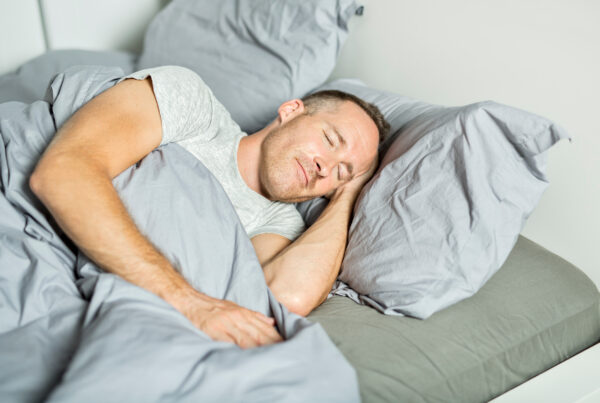”Question: During health literacy month, what can I learn about the positive effects of sleep?
Reading time: 8 Minutes
MWi Hack:
- Sleep is a complex biological process where your body cycles through different stages (including NREM and REM) for about 7-9 hours daily to repair itself, conserve energy, and process memories, though you can hack it by maintaining good sleep hygiene, following consistent schedules, and using appropriate medical interventions if needed.
MWi Summary:
-
- Your body cycles through NREM (3 stages) and REM sleep, with each cycle lasting 90-120 minutes and happening 4-5 times per night
- Adults need 7-9 hours of sleep daily, though requirements vary by age (newborns need 14-17 hours, while teenagers need 8-10 hours)
- During sleep, your body repairs itself, conserves energy, and your brain catalogs memories – similar to a librarian organizing books
- Common sleep disorders include insomnia, sleep apnea, narcolepsy, and parasomnias (like sleepwalking or night terrors)
- Good sleep hygiene includes maintaining consistent sleep schedules, avoiding bright lights/electronics before bed, limiting alcohol/food near bedtime, and making your bedroom sleep-friendly
Sleep
You spend about one-third of your life sleeping, but it’s still something many struggle with. Researchers and experts also struggle with it because of the mysteries surrounding how and why we sleep and what happens to us while we do. Fortunately, advances in medical science are helping people find ways to get the sleep they need.
Overview
What is sleep?
Sleep is a normal body process that allows your body and brain to rest. At first glance, sleep is deceptively simple. For most people, it’s just a matter of getting comfortable, closing your eyes and drifting into slumber. But despite how simple it seems, sleep is one of the most complex and mysterious body processes known to science.
If you’re not getting enough sleep or your sleep quality isn’t good, you’ll probably know it just from how you feel. Without enough quality sleep, your body and brain can’t work as they should. And there’s a whole field of medicine devoted entirely to sleep and treating conditions that affect or disrupt it.
Function
Why do people sleep?
Modern medicine’s understanding of sleep is like a partially assembled jigsaw puzzle. Experts can identify some of the pieces and have an idea of what the big picture looks like, but they haven’t figured out how everything fits together.
Your body cycles between being awake and asleep throughout each day, with certain processes only happening when you’re asleep. When you’re asleep, your body “powers down” and most body systems — including your brain — become less active.
Some of the key things that happen while you’re asleep include:
- Energy conservation and storage. During the day, cells throughout your body use stockpiled resources to keep doing their jobs. While you’re asleep, your body uses less energy. That lets those cells resupply and stock up for the next day.
- Self-repair and recovery. Being less active makes it easier for your body to heal injuries and repair issues that happened while you were awake. That’s also why being sick makes you feel more tired and need more rest.
- Brain maintenance. While you’re asleep, your brain reorganizes and catalogs memories and learned information. This is like a librarian sorting and shelving books at the end of the day. It makes accessing and using things you learn and remember easier and more efficient.
How much sleep do I need?
Sleep is variable from person to person. The way that people sleep and how much they need can vary widely. The number of hours of sleep that are good for your health can also change during your lifetime.
In general, recommended sleep amounts by age are:
| Age | Amount of sleep needed |
|---|---|
| Newborns (birth to 3 months). | Between 14 and 17 hours. |
| Infants (4 months to 12 months). | Between 12 and 16 hours (including naptime). |
| Young children (ages 1 to 5). | Between 10 and 14 hours (including naptime). |
| School-aged children (ages 6 to 12). | Nine to 12 hours. |
| Teenagers (ages 13 to 18). | Eight to 10 hours. |
| Adults (18 and older). | Seven to nine hours. |
These sleep amounts apply to most people, but they aren’t universal. Some people need more sleep, and others need less. Variations in how much sleep you need may even be genetic. For example, some people can inherit the trait of being a “short sleeper” from a parent.
Personal circumstances and your health status can also affect how much sleep you need. People who are sick or recovering from an injury or medical procedure may need to sleep more. Pregnant people often need more sleep during the first trimester, too.
If you have questions about how much sleep you need, especially if it’s different from the amount recommended for your age group, talk to a primary care provider. They can help you understand when that difference might mean there’s a medical issue that needs exploring.
Do I have to get all my sleep at once?
No, getting all of your sleep at once isn’t a hard-and-fast rule. In fact, sleep customs commonly vary by culture and time period. Historically, some cultures embraced splitting nighttime sleep into two periods. Throughout the world, many cultures still embrace the habit of napping. Many have their own word for it (like “siesta” in Spanish-speaking countries or the “inemuri,” a short workplace nap that’s practiced in Japan).
But like too much of anything, napping comes with a drawback. Napping for too long can affect sleep quality overnight. There’s also an increased risk for certain health problems. Talk to your healthcare provider if you often nap or want to try it. That can allow you to get the most benefit from naps without the drawbacks.
What are the stages of sleep?
Sleeping doesn’t mean your brain is totally inactive. While you’re less aware of the world around you, you still have plenty of detectable brain activity. That brain activity has predictable patterns. Experts organized those patterns into stages. The stages fall broadly into two categories: rapid eye movement (REM) sleep and non-REM (NREM) sleep.
There are three NREM stages. When you fall asleep, you typically enter NREM stage 1 and then cycle between NREM stages 2 and 3. After that, you go into REM sleep and start dreaming. After the first REM cycle, you start a new sleep cycle and go back into stage 1 or 2, and the cycle starts over.
One cycle normally takes about 90 to 120 minutes before another begins. Most people go through four or five cycles per night (assuming they get a full eight hours of sleep).
What is stage 1 NREM sleep?
Stage 1 NREM sleep is the lightest stage of sleep. You enter stage 1 right after you fall asleep. This stage usually lasts only a few minutes, making up about 5% of your sleep time. After that, your sleep gets deeper, and you move into stage 2 NREM sleep.
What is stage 2 NREM sleep?
Stage 2 is still light sleep, but deeper than stage 1. During this stage, your brain waves slow down and have noticeable pauses between short, powerful bursts of electrical activity. Experts think those bursts are your brain organizing memories and information from the time you spent awake.
Stage 2 NREM sleep accounts for about 45% of your time asleep (the most of any stage). You’ll go through multiple rounds of stage 2 NREM sleep, and usually, each one is longer than the last. After stage 2, you move deeper into stage 3 NREM sleep or enter REM sleep.
What is stage 3 NREM sleep?
The deepest stage of NREM sleep is stage 3. It makes up about 25% of your total sleep time in adults. But babies and children need more stage 3 sleep, and the older you get, the less you need.
In stage 3, your brain waves are slow but strong. Your body takes advantage of this very deep sleep stage to repair injuries and reinforce your immune system. The same bursts of brain activity that happen in stage 2 can also happen in stage 3, and brain waves specific to stage 3 help regulate those bursts.
You need stage 3 NREM sleep to wake up feeling rested. Without enough stage 3 sleep, you feel tired and drained even if you slept for a long time. That’s why your body automatically tries to get as much stage 3 sleep into your sleeping period as early as possible. After stage 3 NREM sleep, your body moves into stage 2 NREM, which is the gatekeeper of REM sleep.
Because stage 3 NREM sleep is so deep, it’s hard to wake someone up from it. If they do wake up, they’ll probably have “sleep inertia,” a state of confusion or “mental fog.” Sleep inertia lasts about 30 minutes.
What is REM sleep?
Rapid eye movement (REM) sleep is the stage of sleep where most dreams happen. Its name comes from how your eyes move behind your eyelids while you’re dreaming. During REM sleep, your brain activity looks very similar to brain activity while you’re awake.
REM sleep makes up about 25% of your total time asleep. Your first REM cycle of a sleep period is typically the shortest, around 10 minutes. Each one that follows is longer than the last, up to an hour.
Conditions and Disorders
What are sleep disorders, and which of them are more common?
Conditions that disrupt sleep or wakefulness are called sleep disorders. There are six main categories of sleep disorders:
- Central disorders of hypersomnolence (like narcolepsy).
- Circadian rhythm sleep-wake disorders (such as jet lag or shift work sleep disorder).
- Insomnia.
- Parasomnias.
- Sleep-disordered breathing (such as sleep apnea).
- Sleep-related movement disorders (like restless leg syndrome).
Parasomnias can vary widely. Some affect NREM sleep only, while others affect REM sleep only. Organized by possible NREM or REM stage, they include:
Stages 1 and 2 NREM sleep
- Sleep starts or twitches (sleep myoclonus).
- Exploding head syndrome.
- Teeth grinding (bruxism).
- Periodic limb movement disorder (PLMD).
Stage 3 NREM sleep
- Night terrors (also known as sleep terrors).
- Sleepwalking (somnambulism).
- Confusional arousals (partial waking with sleep inertia).
- Periodic limb movement disorder (PLMD).
- Sleep-related eating disorder.
REM sleep
- Nightmares and nightmare disorder.
- REM sleep behavior disorder.
- Hypnagogic and hypnopompic hallucinations.
What tests can determine how long or how well I’m sleeping?
Diagnosing sleep-related conditions can involve a wide range of tests. Some of the most common include:
- Sleep studies (in-lab): The main, most comprehensive form is a polysomnogram, an overnight sleep study in a sleep lab facility.
- Sleep study (at-home): These are less comprehensive, but you can do them from home using an at-home sleep apnea testing device. Providers only use this test to confirm if a person has obstructive sleep apnea.
- Electroencephalogram (EEG): This test detects and records brain waves. Your healthcare provider, usually a neurologist, can examine your brain activity for signs of unusual brain activity that could contribute to sleep problems or other conditions. A polysomnogram includes EEG sensors and tracking to record brain waves, which a provider can compare to other data.
- Actigraphy: This test involves wearing a device similar to a watch that tracks sleep patterns to see if you may have a different sleep cycle than is typical. This is key in diagnosing circadian rhythm disorders.
- Multiple sleep latency test (MSLT): This test examines whether a person is prone to falling asleep during the daytime. It’s often a key part of diagnosing narcolepsy.
- Maintenance of wakefulness test (MWT): This test looks for whether or not a person can resist falling asleep in situations where it would be easy to do so. It’s a common part of safety testing for people who drive for a living and may have conditions like sleep apnea.
Other tests are also possible when you might have a sleep disorder or sleep-related issue. Your provider can tell you the tests they recommend and answer any other questions you have.
What are common treatments for sleep problems?
The treatments for sleep disorders and sleep-related issues can vary widely. Some issues don’t need treatment at all, and others might need lifelong care or treatment (an example is CPAP support for people with sleep apnea). Your healthcare provider can tell you more about treatments that might help your condition (if you have one) and what your options are.
Care
What can I do to make sure I’m getting enough quality sleep?
If you ever ask yourself, “How can I get a good night’s sleep?” you’re hardly alone. You can do several things to make it easier to get the amount of quality sleep you need. These behaviors all fall under what healthcare providers call “sleep hygiene.” They include:
- Set and keep to a sleep schedule. Go to bed and wake up at the same time every day, including weekends and vacations. Being consistent can make a big difference in how much and how well you sleep.
- Make time for sleep. Pick a bedtime that allows you to get the recommended amount of sleep for your age.
- Have a bedtime routine. Going through these actions can “train” your brain that sleep is coming. Your brain will eventually go along with that training.
- Don’t go to bed unless you feel sleepy. If it’s bedtime and you don’t feel sleepy, try and do things that will help you wind down and relax (especially activities from your bedtime routine, like reading).
- Avoid bright lights or electronics (especially around bedtime). Light from these too close to bedtime can disrupt your body’s natural sleep-wake functions.
- Avoid drinking alcohol or eating a meal too close to bedtime. A light snack is the best option if you feel hungry before bedtime. Alcohol and food can disrupt sleep (especially when you consume too much of either). And try not to drink too much of any beverage too close to bedtime. That limits how often you feel you need to go to the bathroom during the night.
- Don’t rely on sleeping medications. Long-term use of sleeping pills and other medications — even ones available over the counter — can negatively affect your sleep. The only sleep-related medications you should use regularly are the ones your healthcare provider prescribes, and you should only take them as instructed.
- Physical activity can help. Staying active during the day, even just going for a walk, can help with the quality of your sleep.
- Use your bedroom for bedroom activities. That generally means sleeping and intimacy or sex. Your brain uses that sense of place in subtle ways that can affect how you sleep.
- Reach and maintain a healthy weight. Your weight can affect your sleep. An example of this is having excess weight, which can increase your risk of developing obstructive sleep apnea.
What are sleep medications, and how can they help?
There’s an array of medications that can help you sleep. They range from over-the-counter supplements and drugs to prescription medications. Many fall under the umbrella of sedatives (which reduce nervous system activity) or hypnotics (named for the Greek god of sleep).
IMPORTANT: Sleep medications, even over-the-counter ones, can interact with other medications. Those interactions can be dangerous or deadly. It’s best to talk with a healthcare provider to make sure taking these products is safe. You should also avoid alcohol use while taking them and talk to your provider about possible interactions with other medications you take.
Some examples of prescription sleeping pills and sleep-promoting medications include:
- Z-drugs: Experts sometimes call these nonbenzodiazepines because their effects and how your body processes them are very similar to benzodiazepines, but have fewer and less-severe side effects.
- Dual orexin receptor antagonists (DORAs): DORAs block orexins, a molecule your brain uses to keep you awake, so they help you sleep. Examples of these include daridorexant, lemborexant and suvorexant.
- Benzodiazepines: These mainly treat seizures or anxiety-related conditions, but have seen widespread use for treating insomnia or related sleep problems.
- Antidepressants: These can affect levels of certain neurotransmitters in your brain. They can also have a sedating effect (this isn’t common).
- Barbiturates: Use of these for sleep-related issues is less common today. Newer drugs with a lower risk of side effects are more common now, but barbiturates still see use for insomnia (but this is rare).
Common over-the-counter sleep aids can include:
- Antihistamines: Many of these contain diphenhydramine or doxylamine. These drugs reduce allergic reactions and make most people drowsy.
- Melatonin: Your body uses this hormone to regulate your sleep-wake cycle. You can also take it to help with sleep. While it’s available over the counter, melatonin isn’t something you should use without talking to your healthcare provider first (especially if you’re over age 65). Your provider can advise you on whether you should take melatonin products, as well as help you understand how to use them effectively.
- Valerian root: This root is a common ingredient and can come in various forms. Some people take it in pill form, while others prefer to make tea from it.
Additional Common Questions
Why is sleep important, and what are the effects of lack of sleep?
To understand why sleep is important, look no further than the effects of a lack of sleep. Many things can affect how much or how well you sleep. Not sleeping enough can cause the following short-term effects:
- Slowed reflexes.
- Trouble thinking or concentrating.
- Mood effects, including feeling irritable, depressed or anxious.
- Headaches.
- Decreased immune system effectiveness and getting sick more often.
- Metabolism problems and a higher risk of developing Type 2 diabetes.
- Feelings of fatigue or exhaustion.
If you go for too long without enough sleep, your body’s need for sleep will become more and more disruptive. That can cause:
- Microsleeps: These are brief moments where your brain falls asleep only to snap back awake again. They’re especially dangerous if they happen while you’re driving, using tools or machinery, or doing something that requires your full attention.
- Hand tremors: Your nervous system will have trouble regulating muscle movements and muscle tone if you go too long without sleep.
- Hallucinations: Sleep deprivation can disrupt your brain’s ability to process information about and understand the world around you. That can cause you to see, hear or feel things that aren’t there.
- Impulsive or reckless behavior: Lack of sleep can impair the parts of your brain responsible for self-control and judgment.
Sleep deprivation also has long-term health impacts. Research shows it may contribute to the following conditions:
- Cardiovascular disease.
- Metabolic conditions like Type 2 diabetes.
- Cognitive impairment.
- Dementia.
What is a sleep debt?
A sleep debt is the difference between the amount of quality sleep you got and the amount of quality sleep you needed. It can make you feel even more tired than normal, and you may need to sleep more to feel rested.
Research shows that having an accumulated, chronic sleep debt isn’t good for you. Catching up on that missed sleep may also not help undo the effects of the accumulated debt. One example is how a sleep debt can affect your body’s metabolism, increasing the odds of developing Type 2 diabetes and other issues. There’s evidence that even with catch-up sleep to “pay off” the debt, your metabolism may still show the effects of the debt.
A note from Cleveland Clinic
Sleep is a natural process that your body uses to rest and repair itself. While it might seem as simple as closing your eyes and nodding off, sleep is anything but simple. In fact, modern medicine’s understanding of sleep, what it does and how it works is just getting off the ground.
If you’re experiencing issues affecting your sleep, you’re definitely not alone. And there’s a whole field of medicine devoted entirely to sleep and the conditions that can affect it. Talk to a healthcare provider if you feel like you’re spending more time chasing ZZZs than catching them and resting. That way, you can put those issues — and yourself — to rest.
MWi would like to thank Cleveland Clinic for sharing these insights with our community. Click the button below to be directed to the original content:






